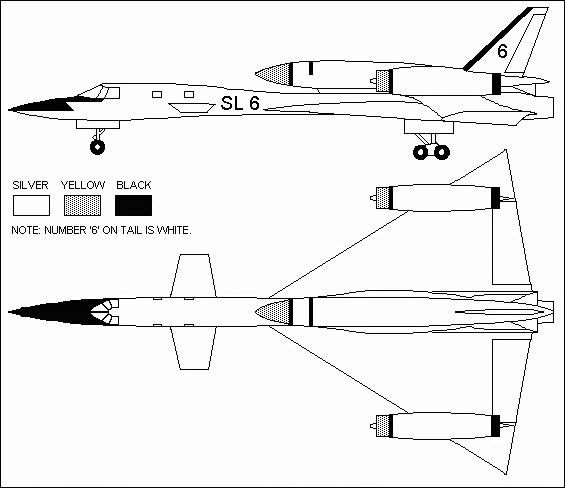The SL 6 Supersonic Airliner was significant in that it was the first model kit based futuristic aircraft to appear in a Supermarionation series. The SL 6 was the direct ancestor of the many model kit based futuristic aircraft which would appear in Stingray, Thunderbirds, and beyond.
The SL 6 was not the first model kit based aircraft to appear in an Anderson television series. The first episode of Supercar, 'Rescue', featured two aircraft studio miniatures which were based upon commercial plastic model kits. These were Bill Gibson's airplane (a Monogram Piper Tri-Pacer) and a US Navy rescue helicopter (a Revell Sikorski H-19 on floats). Both of these model aircraft were filmed as built 'right out of the box' with few if any modifications. The SL 6 Supersonic Airliner, on the other hand, was a radical kit conversion that bared little resemblance to the original Lindberg B-58 'Hustler' kit upon which it was based.
The SL 6 Supersonic Airliner was built for use in the Fireball XL5 episode 'Space City Special'. In this episode, the aircraft is used to take Dr Venus and General Rossiter to Space City. Unfortunately, Major Todd, the jet's pilot, was conditioned by the evil Subterrains to throw the aircraft into a crash-dive when it reached an altitude of 40,000 feet. As the aircraft commences its dive, Steve Zodiac and Professor Matic fly to the rescue in Fireball Junior. Coming up alongside the stricken SL 6, they are able to talk Dr Venus through the landing procedure and all ends well.
It would appear that at least two SL 6 models were built for use in 'Space City Special'. (However, it is also possible that only one model was built and this one was progressively modified as shooting went on.) One of the models was built in the standard configuration as seen in the drawing below. The other model was built with the wing engines pointed 'downwards' (in an impossible but visually interesting manner which made the jet exhausts point upwards!) for a vertical landing at the story's climax. Although the Lindberg B-58 kit was equipped with operating landing gear, it would seem that this feature was not used by the APF film crew, possibly because the kit's plastic landing gear had to be strengthened with wire. When seen in flight, the landing gear bays can be seen to be open and empty. Apparently the landing gear was simply removed for the flight scenes.
The flight configured SL 6 model was subsequently destroyed in the following episode, 'The Firefighters'. In this episode, the aircraft was destroyed by a ball of flaming gas from outer space!
Each SL 6 miniature was built from a Lindberg Convair B-58 'Hustler' model kit and the horizontal stabilizer fin from an unknown Lockheed F-104 'Starfighter' kit. Basically, the SL 6 Supersonic Airliner was made from the B-58 as follows:
- The fuselage was built basically according to plan and then the tail fin was cut off.
- One of the outboard jet engine pods was grafted on to the end of the fuselage, lengthening it by about three inches.
- The fuel tank/nuclear weapon pod was assembled and attached to the top of the fuselage with the end even with the jet exhaust, and then the two 'upper' fins were removed.
- The tail fin was trimmed back and then attached to the top of the fuel tank/nuclear weapon pod.
- The wings were attached to the fuselage about three inches behind their normal positions.
- The inboard engines were attached to the tops of the wings.
- The F-104 horizontal stabilizer was cut in half lengthwise and then attached to the front of the aircraft as a canard surface.
Let's take a closer look at the SL 6 Supersonic Airliner:

This view of the SL 6 shows the basic layout of the design. Note that the fuselage and landing gear parts were built essentially according to the Lindberg B-58 kit's plan. Note the new position of the fuel tank/weapon pod on top of the fuselage. Note that two of the small triangular fins were removed from the 'top' of the fuel tank. The vertical stabilizer (tail) fin and rudder is the original B-58 kit part which has been cut back lengthwise and in height. Note the new positions of the inboard jet engine pods on top of the wings directly opposite where they would normally go. Not obvious is the outboard jet engine pod grafted to the back of the fuselage, the canards made from an F-104 horizontal stabilizer, and the large expanse of filler required to fill the gaps in the fuselage caused by the wings being glued three inches behind their normal positions.
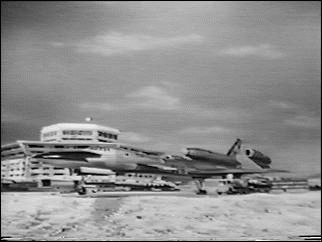
This is a front view of the SL 6 which shows how the Lindberg kit's black anti-glare panel decal was applied to the nose of the model in an "upside down" position.
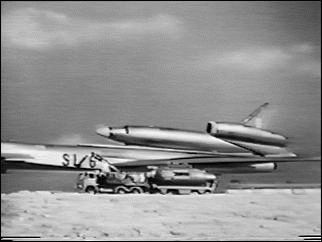
Here is a detail view of the mid-fuselage area showing the overwing engines and the black 'SL 6' dry transfer lettering (Lettraset brand). Note the large flat expanse of filler putty over the area where the wings should have been seated had they been applied to the model in accordance with the kit's instructions.
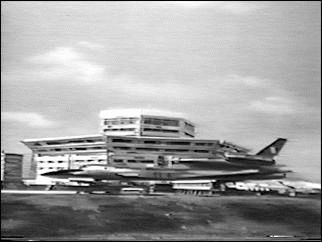
This is a side view of the SL 6 in front of the airport terminal building. Note the very bright silver finish. What you can't see in this image is the panel detail applied by the APF model maker. In many cases a simple paneling treatment was given to models with small rectangles of transparent adhesive tape. The taped over sections reflected the light differently than the plain painted surfaces of the model and gave the illusion of "scale".
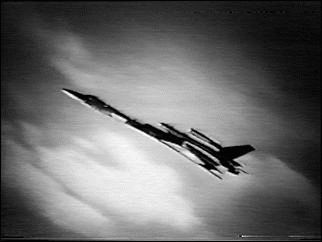
The SL 6 in flight on its way up to 40,000 feet and disaster! When the APF effects team dreamed up the SL 6, they were probably thinking about the USAF XB-70 hypersonic bomber prototypes.
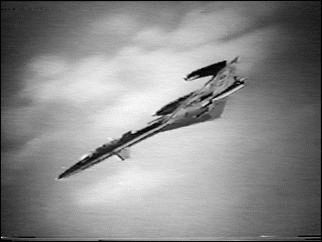
The SL 6 on the way down. Note the anhedral of the canards, the outboard engine grafted onto the back of the fuselage, and the open landing gear wells on the bottom of the wings. As was typical of most of the models done by the APF effects team, the level of detail incorporated into the SL 6 miniature was only that which was sufficient for filming purposes. This model would never have stood up to close examination.
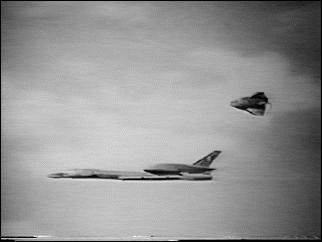
Here is the SL 6 flying in formation with Fireball Junior with Dr. Venus at the controls.
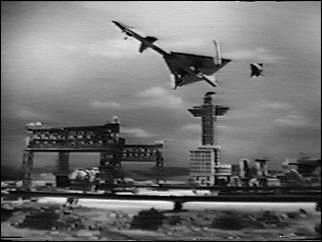
The SL 6 model that was built in vertical landing configuration with wing engines pointed downwards. As the engines are tilted forwards, the exhausts are actually pointing upwards instead of downwards! These do not appear to be the B-58 kit's engines. Indeed, they may actually have been made from a pair of Gerry Anderson's discarded metal cigar tubes. The effects people often salvaged Gerry's cigar tubes and used them to contain pyrotechnic rocket motors.
Gerry Anderson has stated on a number of occasions that he was watching television or reading a magazine one night and saw NASA's "Flying Bedstead", a strange open metal framework encompassing a jet engine that was used by the astronauts to practice vertical landing techniques in preparation for the f irst moon landing. He was very impressed with this thing and when he went into the studio the next day, he ordered that a vertical take off and landing (VTOL) aircraft model be built. As the SL 6 was the first VTOL aircraft model to appear in a Supermarionation program, it is quite possible that the SL 6 was that very same model.
